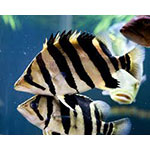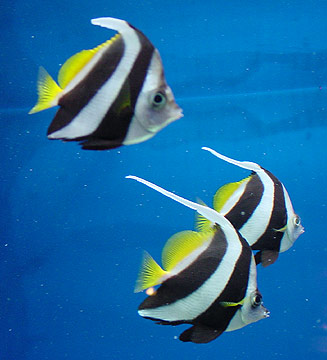Indonesian Tiger Fish

|
Scientific Name: Datnioides microlepis Price: Upon Request Origin: Asia Family: Datnioididae NOT AVAILABLE NOW |
|
Other Names: Siamese Tiger Fish, Gold Datnoid, Finescale Tigerfish |
|
Technical Info
Temperature: 24 - 27 ℃
pH: 7 - 7.5
GH: 8 - 20
Max size: 38 cm
Min Tank size: 400 Ltr
Position in Aqua: No special swimming level
Description
The Indonesian Tiger Fish is a deep bodied fish with a sharply slanted forehead. It has a golden toned body with black vertical bars. They are usually full bars extending across the entire body. Depending upon the geographic location, they can have between 5 and 7 bars.
Food
Indonesian Tiger Fish are primarily carnivores. They are a predator that in the wild primarily feeds on fish fry and small fishes, small shrimps, crabs, worms, and insect larvae. In the aquarium their main diet consists of smaller fish although they can sometimes be coaxed into eating shrimp, worms or insects. One look at their large mouth will tell you that small tank mates will disappear quickly. They are not aggressive towards other species but will attempt to eat any fish that will fit into their mouth.
Breeding
Not thought to have been achieved in the hobby. There is at least one incident of eggs being produced, but there were no resultant fry.
Compatible with
While it is highly predatory and will consume any fish it can fit in its mouth, it is fairly peaceful with similarly-sized species. It can actually be intimidated by very boisterous tankmates, such as many Central American cichlids. Better choices include arowana, large characins and cyprinids, freshwater stingrays, Polypterus and medium-sized catfish. It is generally quite aggressive towards conspecifics and other similar looking species. As a result it should never be kept in pairs, as one fish will often end up being hounded mercilessly. Either keep it as a single specimen, or in a group of 3 or more. It can also be kept in mixed-species shoals with other freshwater Datnioides species without too much trouble.
Note
Sexual differences are unknown.

